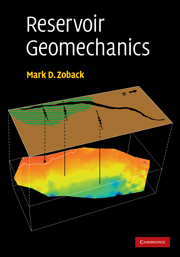Book contents
- Frontmatter
- Contents
- Preface
- PART I BASIC PRINCIPLES
- PART II MEASURING STRESS ORIENTATION AND MAGNITUDE
- 6 Compressive and tensile failures in vertical wells
- 7 Determination of S3 from mini-fracs and extended leak-off tests and constraining the magnitude of SHmax from wellbore failures in vertical wells
- 8 Wellbore failure and stress determination in deviated wells
- 9 Stress fields – from tectonic plates to reservoirs around the world
- PART III APPLICATIONS
- References
- Index
- Plate section
6 - Compressive and tensile failures in vertical wells
Published online by Cambridge University Press: 10 December 2009
- Frontmatter
- Contents
- Preface
- PART I BASIC PRINCIPLES
- PART II MEASURING STRESS ORIENTATION AND MAGNITUDE
- 6 Compressive and tensile failures in vertical wells
- 7 Determination of S3 from mini-fracs and extended leak-off tests and constraining the magnitude of SHmax from wellbore failures in vertical wells
- 8 Wellbore failure and stress determination in deviated wells
- 9 Stress fields – from tectonic plates to reservoirs around the world
- PART III APPLICATIONS
- References
- Index
- Plate section
Summary
The principal topics I address in this chapter are the relationships among in situ stress magnitudes, rock strength and the nature of compressive and tensile failures that can result from the concentration stress around a wellbore. To establish the principles of wellbore failure with relatively simple mathematics, I consider in this chapter only vertical wells drilled parallel to the vertical principal stress, Sv. In Chapter 8 I generalize this discussion and consider deviated wells of arbitrary orientation in an arbitrarily oriented stress field.
In some ways every well that is drilled can be thought of as a rock mechanics experiment. The formation surrounding the wellbore wall is subject to a stress concentration that varies strongly with the position around the well and the distance from the wellbore wall. The way in which this formation responds to the stress concentration is a function of both the stress field and rock strength. As discussed in Chapter 7, detailed knowledge of the nature of wellbore failure (especially as revealed by wellbore imaging, as discussed in Chapter 5) allows one to estimate (or constrain) the magnitude and orientation of in situ stresses at depth. In some cases it also allows one to obtain direct information about rock strength in situ.
The concentration of stress around wellbores can lead to compressive failures known as stress-induced breakouts and/or tensile failure of the wellbore wall that we will refer to as drilling-induced tensile wall fractures.
- Type
- Chapter
- Information
- Reservoir Geomechanics , pp. 167 - 205Publisher: Cambridge University PressPrint publication year: 2007

